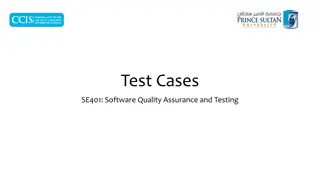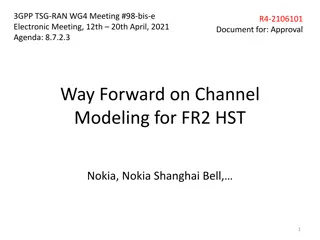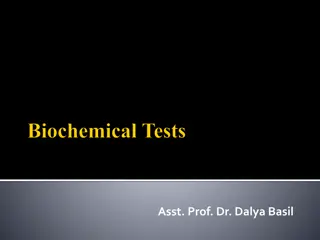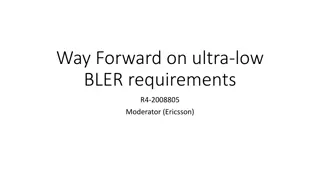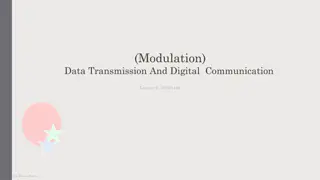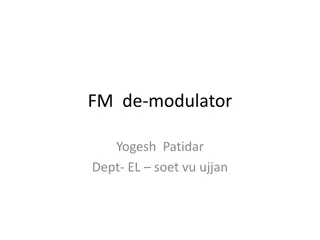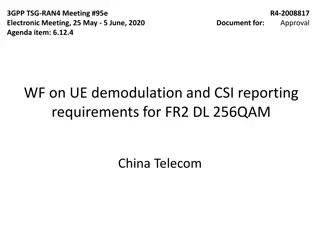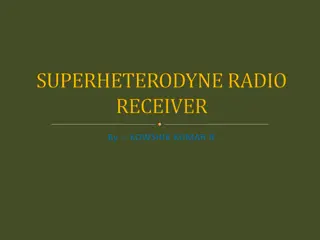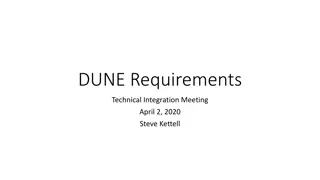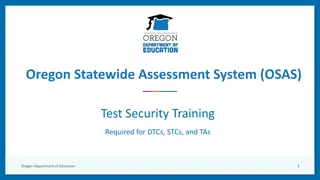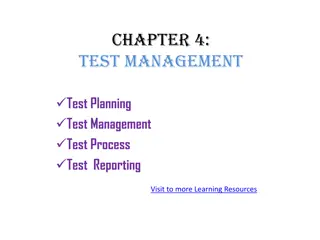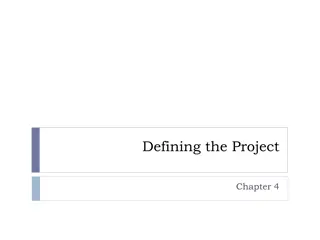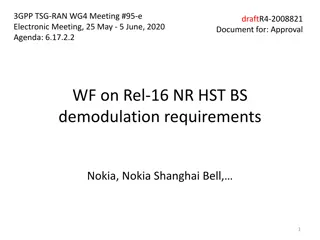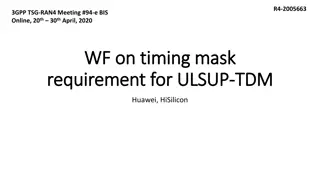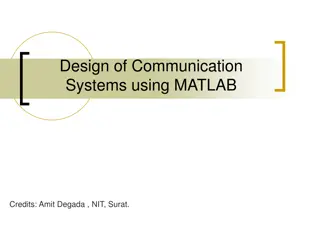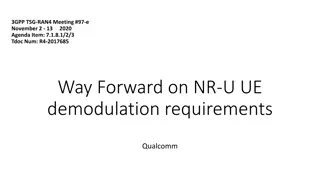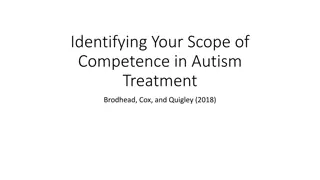Test Scope and Requirements for NR-U UE Demodulation
The documentation discusses the test scope and requirements for demodulation of NR-U UE, emphasizing semi-static and dynamic channel access devices. It covers specifics such as test scenarios, DL transmission options, CQI requirements, and downlink transmission model. The aim is to prioritize test cases agnostic to channel access devices, define tests for unlicensed CC, and set parameters for CQI reporting tests. Various options for bandwidth usage and transmission models are also detailed.
Download Presentation

Please find below an Image/Link to download the presentation.
The content on the website is provided AS IS for your information and personal use only. It may not be sold, licensed, or shared on other websites without obtaining consent from the author.If you encounter any issues during the download, it is possible that the publisher has removed the file from their server.
You are allowed to download the files provided on this website for personal or commercial use, subject to the condition that they are used lawfully. All files are the property of their respective owners.
The content on the website is provided AS IS for your information and personal use only. It may not be sold, licensed, or shared on other websites without obtaining consent from the author.
E N D
Presentation Transcript
3GPP TSG-RAN4 Meeting #97-e November 2 - 13 Agenda Item: 7.1.8.1/2/3 Tdoc Num: R4-2017465 2020 Way Forward on NR-U UE demodulation requirements Qualcomm
Test Scope Semi-static Channel Access Devices v/s Dynamic Channel Access Devices Prioritize test cases agnostic to semi-static and dynamic channel access devices. Do not define additional test cases dedicated to FBE/LBE devices.
Test Scope Test Scenarios Define requirements for the unlicensed CC, and apply to both Scenario A and C; FFS: Details of the test set-up for scenario A and C; For reference: Scenario A (Carrier aggregation between licensed band NR (PCell) and NR-U (SCell)) Scenario C (Stand-alone NR-U (PCell))
Test Scope Define tests with fixed DL Transmission (COT) duration Option 1: No, use random COT from a set of values; Option 2: Yes, using 2ms duration; Values for random COT (if option 1 is agreed) Option 1: {2, 6, 10, 16} Slots; Option 2: {1,3,5,8} for SCS 15kHz, {1,6,10,16} for SCS 30kHz; Define tests with fixed DRS window duration set to 1ms; FFS: Deprioritize tests with COT duration larger than SMTC duration for dynamic channel access devices
Test Scope Do not define tests for NR-U Demod PDCCH demodulation requirements; FFS whether to define CQI Requirements, discuss the parameters and UE behaviour for CQI reporting tests; Bandwidth to be used for Requirements definition Option 1: 20 and 80 MHz; Option 2: 20, 40, 60 and 80 MHz with applicability rule to test the largest supported BW; Option 3: 40MHz (as in rel-15 TDD Demod);
Downlink Transmission Model Option 1: Select the number of slots randomly from a given set of the number of slots {2, 6, 10, 16} with equal probability as the total length of burst transmission format. The length includes both occupied OFDM symbols and non-occupied OFDM symbols within the burst format. The starting position for the first slot is randomly selected from OFDM symbol S1 :{0, 7} with equal probability. For PDSCH type A test: if 0 is selected, the PDSCH type A is transmitted from symbol 2 of the first slot. If 7 is selected, the PDSCH type A is transmitted from OFDM symbol 2 of second slot. For PDSCH type B test: if 0 is selected, the PDSCH type B is transmitted from symbol 2 of the first slot. If 7 is selected, the PDSCH type B is transmitted from symbol 7 of the first slot. In the last slot, PDSCH is transmitted ending with position of OFDM symbol randomly selected from OFDM symbol S2: {5,8,11,13} with equal probability A uniform random variable from [0, 1] is generated. If the random variable is less than p which is given per test case, If both the last slot of previous burst and first slot of new burst format are fully occupied, start burst transmission after deferring one slot from the last slot of previous burst. Otherwise, start burst transmission at the end of last slot of previous burst. Otherwise, the burst transmission is muted and the muting duration is the same as the number of slots for determined burst format. Option 2; Compute COT and Unoccupied duration as specified by Test Parameters, then repeat it periodically for the entire test; Fully allocate PDCCH and PDSCH in COT, except for Guard and UL Symbols at the end of COT as specified by Test Parameters; Use a threshold pLBT to control randomized LBT failures;
Downlink Transmission Model Slot format Option 1: For 30kHz, 2ms Duration, DDDS (S=7D:2G:2U); Option 2: For 30kHz, 7D -1S-2U; Other Parameters Option 1: Maximum COT Duration Minimum Idle Time after COT Fixed Frame Period (Note 2) ms ms ms 1.9 0.1 2 Probability of LBT Failure pLBT Guard Symbols UL Symbols Number of slots between PDSCH and corresponding HARQ-ACK information [TBD] 2 Symbols 2 Symbols 3 if mod(i,4) = 0 2 if mod(i,4) = 1 5 if mod(i,4) = 2 4 if mod(i,4) = 3 DL Transmission Model (Note 1) Notes: 1) 2) According to the definition proposed in [2] This Parameter applies only for ChannelAccessType-r16 = semistatic .
LBT Parameters Do not define tests with sub-band LBT failure. Model LBT Failure as part of the Downlink Transmission model; Apply the Downlink Transmission model to all DL signals in unlicensed carrier (including SSB and TRS transmission); FFS whether is needed to define a separate LBT model for FBE and LBE;
LBT Parameters Probability of LBT Failure for Scenario C: Option 1: 0 (always clear channel); Option 2: Same probability as Scenario A; Option 3: TBD>0 (probability of occupied channel); Probability of LBT Failure for Scenario A: Option 1: TBD>0 (probability of occupied channel)
Simulation Assumptions for PDSCH Tests Use LTE LAA PDSCH requirements as starting point. Use Burst Transmission Model for LAA (36.101-4, B.8) as a starting point. Use 20 MHz LBT BW. Do not multiplex SSB and Data. Define tests for TDD 30kHz. Define tests with low delay spread and low doppler speed propagation channel.
Simulation Assumptions Test Design Option 1: Use NR PDSCH Demod Performance Tests as a starting point (R16 NR CA for Scenario A, R15 PDSCH for Scenario C); Option 2: Use LTE LAA Demod Performance Test setup as a starting point for scenario A ???= 8; Q factor for SSB: ????
PDSCH Simulation Assumptions PDSCH Type Option 1: Type A only; Option 2: Type B only for UE with capability, Type A otherwise; Option 3: Type A plus Rel-15 Type B for partial slots, dedicated test to verify typeB- PDSCH-length-r16 capability with corresponding applicability rule; PDSCH Type B Start and Length for PDSCH Performance Tests (if agreed to use PDSCH mapping Type B) Option 1: Subset of fixed [start, length] values: [2,4], [2,12]; Option 2: Random start in Symbol {2, 9} and length {12, 5} for first slot of burst. Start in Symbol 2 and length {4, 7, 10, 12} for last slot of burst. Start in Symbol 2 and length 12 for other slots; Option 3: Start in Symbol {7} and length {4} symbols;
PDSCH Simulation Assumptions Length of the last Slot in the burst Option 1: Random length, {6, 9, 12, 14} Symbols with the first 2 symbols allocated for PDCCH transmission; Option 2: Fixed length according to proposed model; PDCCH Format to be used Option 1: Format 2-0, using CO-DurationPerCell-r16 to indicate the COT duration (Apple); Option 2: Do not use DCI Format 2-0 (Qualcomm, Ericsson);




